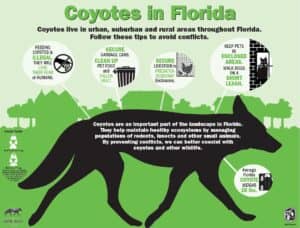What you need to know about Florida’s urban coyotes

You might see it sprinting across a neighbor’s yard, or trotting down a sidewalk, a small, gray or brownish canine that doesn’t look quite like any dog you’ve ever seen. The animal is slinky and furtive, its eyes darting left and right, and it’s gone within a matter of seconds.
There are coyotes among us.
Indigenous to the Western United States, canis latrans has been documented in every state but Hawaii. According to the Florida Fish and Wildlife Conservation Commission, there are now coyotes in all 67 Florida counties.
“Coyotes began expanding their range into northwestern Florida in the 1960s,” says FWC spokesperson Lisa Thompson. “It is now considered to be a naturalized species – not invasive, as they were not introduced to the state by human means.”

Image: Nextdoor.
Coyotes are versatile animals and extremely adaptable, like raccoons and opossums, to urban and suburban environments. And although they’ve been known to appear during daylight hours, like those smaller (and similarly opportunistic) mammals, they’re mostly active at dawn and dusk, and under cover of darkness. That’s prime feeding time, when coyotes are on the hunt for rodents, birds and insects. And raccoons. And opossums. They also eat pet food. They also eat garbage.
A coyote will catch, kill and eat pretty much any animal smaller than it is, which is why FWC recommends keeping cats and small dogs indoors.
“Coyotes,” explains Thompson, “are generalist feeders and will take advantage of easy access to accessible food sources.”

Image: Facebook.
The coyote is, wildlife biologists stress, not a danger to humans. By and large, it is a timid animal and will shy away from interaction. “Coyotes also become more difficult to scare away if they lose their fear of people,” according to the FWC website. “But, like other wild animals, that tendency will vary from one coyote to another.
“Coyote attacks on dogs and cats have been reported in Florida. In some cases, pet owners were present at the time of the attack. However, unprovoked coyote attacks on humans are very rare. There have been very few reported instances of humans being bitten by coyotes in Florida.”
Coyote mating season is January through March, and the animals instinctively become protective of their hidden-away dens and the pups inside. It’s important to be particularly vigilant during this time, as the animals might see larger dogs as threats, and engage with them in “territorial disputes.”
As with raccoons, coyotes can contract rabies, and any animal not displaying its natural fear of humans should be given a wider-than-usual berth.
Living with coyotes
The City of St. Petersburg refers calls about coyotes to Pinellas County Animal Services. According to director Doug Brightwell, the county has sometimes had to respond to calls about badly injured or sick coyotes, which most times result in euthanasia. Otherwise, he says , “it’s not feasible to eradicate them, and you cannot relocate them. So we try to teach communities how to co-exist with them.”

Photo: FWC.
Elaborates Thompson: “Coyotes respond to external pressures such as hunting and food availability by adjusting their breeding behavior. Litter size can increase when external pressures like hunting/trapping or competition impacts the population.
“Removal of all coyotes from an area is typically ineffective in addressing conflicts if attractants remain around homes and neighborhoods, as new coyotes quickly move into areas where others have been removed. Prevention is key in avoiding conflicts with coyotes.”
In other words, they’re not going away any time soon.
FWC maintains a web page about Florida’s urban coyotes. The agency says that “hazing” a coyote that might be getting a little too close for comfort will typically cause it to leave the area:
“Waving your arms in the air and yelling will usually get a coyote to retreat, unless there is a den with pups nearby. You may need to move towards the coyote and increase hazing if the animal does not immediately run away. Once the coyote begins to move away, it is important to continue hazing efforts until the coyote has completely left the area.
“Noisemakers are often effective deterrents to coyotes, including air horns, banging pots and pans and homemade noisemakers. A ‘coyote shaker’ made from placing pebbles or coins in an empty drink container can be an effective noisemaker.”
The agency suggests not running from a coyote, as this may cause the animal to chase, and to teach children to recognize coyotes. If children are approached, have them move slowly inside while yelling loudly.
More tips from FWC
- Avoid attracting coyotes and other wildlife into your yard by removing or securing attractants – secure your trash, feed pets inside, clean grills and pick up any fallen fruit or bird seed from the yard. Never feed coyotes or other wildlife. Close off any crawl spaces under porches and sheds to prevent coyotes and other wildlife from resting or denning there. Encourage your neighbors to do the same.
- Prevent interactions with pets – keep cats indoors and walk dogs on a short leash, using caution when walking pets in wooded areas or near heavy foliage where coyotes could den or rest. Be extra careful if you are going to walk your pet in wooded areas or areas that have heavy foliage, where coyotes may rest.
- If pets are kept in a fenced area, the fence should be high enough (about 6 feet) to deter coyotes and other wildlife from jumping over, and check the bottom of the fence regularly to make sure that coyotes and other wildlife cannot crawl underneath. If the fence is shorter than six feet, pets should be monitored.
Florida Fish and Wildlife Conservation Commission coyote web page









Kathleen Gray
February 14, 2023at2:05 am
Please not the coyotes started their trek south in the Pinellas area in about 1940-1950’s. I had an uncle who wrote about Florida wild life and Fiona in the 50’ for St Peter Times. (Fredrick Walden) he told my husband that the coyotes have breed their way south in Pinellas county and cannot find their way out now due to over population and a wonderful habitat for them to thrive. I was out walking my dog in the Placido Bayou area and 2 just appeared without a sound! Very scary! Just be very aware of your surroundings!
Shirley Hayes
February 13, 2023at7:16 pm
Thank you for this article. I have seen them in St. Pete and surrounding communities. Thank you for the education.
Georgia Earp
February 11, 2023at9:55 pm
Thank you, Bill DeYoung, for an informative and comprehensive guide to urban coyotes! BTW – Thank you for all the articles about the art and music scenes as well St Pete history. I always rnjoy reading them.
Lauren K Lopez
February 11, 2023at6:08 pm
Thank you for posting this very informative article and the guidelines stated within. I grow weary of the constant hysteria on the NextDoor app from people terrified of or wanting the coyotes removed. This article needs a to be made available to a much wider audience. Again, excellent article with very educational information. Thank you.